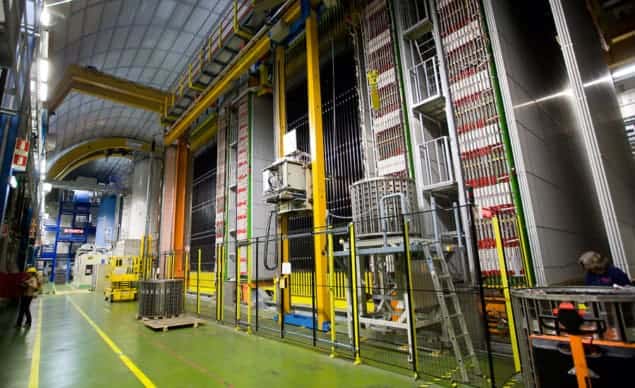
Can particles travel faster than the speed of light? Most physicists would say an emphatic “no”, invoking Einstein’s special theory of relativity, which forbids superluminal travel. But now physicists working on the OPERA experiment in Italy may have found tantalizing evidence that neutrinos can exceed the speed of light.
The OPERA team fires muon neutrinos from the Super Proton Synchrotron at CERN in Geneva a distance of 730 km under the Alps to a detector in Gran Sasso, Italy. The team studied more than 15,000 neutrino events and found that they indicate that the neutrinos travel at a velocity 20 parts per million above the speed of light.
Simple measurement
The principle of the measurement is simple – the physicists know the distance travelled and the time it takes, which gives the velocity. These parameters were measured using GPS, atomic clocks and other instruments, which gave the distance between source and detector to within 20 cm and the time to within 10 ns.
This is not the first time that a neutrino experiment has glimpsed superluminal speeds. In 2007 the MINOS experiment in the US looked at 473 neutrinos that travelled from Fermilab near Chicago to a detector in northern Minnesota. MINOS physicists reported speeds similar to that seen by OPERA, but their experimental uncertainties were much larger. According to the OPERA researchers, their measurement of the neutrino velocity is 10 times better than previous neutrino accelerator experiments.
‘Totally unexpected’
“This outcome is totally unexpected,” stresses Antonio Ereditato of the University of Bern and spokesperson for the OPERA experiment. “Months of research and verifications have not been sufficient to identify an instrumental effect that could explain the result of our measurements.” While the researchers taking part in the experiment will continue their work, they look forward to comparing their results with those of other experiments so as to fully assess the nature of this observation.
Although a measurement error could be the cause of the surprising result, some physicists believe that superluminal speeds could be possible. Its discovery could help physicists to develop new theories – such as string theory – beyond the Standard Model of particle physics. However, the OPERA measurements will have to be reproduced elsewhere before they are accepted by the physics community.
Jenny Thomas of University College London, who works on MINOS, said “The impact of this measurement, were it to be correct, would be huge. In fact it would overturn everything we thought we understood about relativity and the speed of light.”
Alexei Smirnov, a high-energy physicist at the Abdus Salam International Centre for Theoretical Physics, Italy, says that he finds the OPERA result “extremely surprising” as while some small deviation could have been expected, the observed deviation is very large – much larger than what is expected from even very exotic theories. “If this result is proved to be true, the consequences for modern science would undoubtedly be enormous,” he says. He agrees with the conclusion of the OPERA collaboration that currently unknown systematic effects should be looked for and they should continue observations. Smirnov was one of three researchers who discovered the “matter–mass” effect that modifies neutrino oscillations in matter.
Talking about neutrinos
On Friday afternoon, OPERA researcher Dario Autiero from the Institut de Physique Nucleaire de Lyon discussed the details of their experiment at a seminar at CERN. Autiero addressed possible reasons for the result that took into consideration everything from inherent errors during calibration of clocks, to tidal forces and the position of the Moon with respect to CERN and Gran Sasso at the time of the readings.
They considered the possibility of problems internal to the detector itself, the chances of which OPERA researchers say were reduced thanks to the independent external calibration methods they used. They also discussed if it would be possible to re-create the results at different energies. “We don’t claim energy dependence or rule it out with our level of precision and accuracy,” said Autiero. The final note of the seminar seemed to suggest that the real reason is indeed a mystery for the time being and further analysis will definitely be required.
The discovery is described in arXiv:1109.4897 (PDF).



